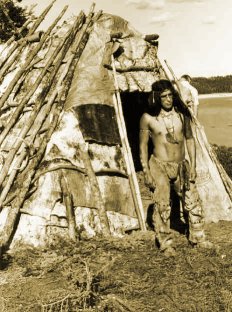
A Mi'kmaw history
Kejimkujik National Park and National Historic Site
While Kejimkujik has been a popular national park for more than four decades, its importance to the Mi’kmaw people is based on millennia of ancestral history. For many centuries, this particular part of Nova Scotia where Kejimkujik now lies was a place of encampments, fish weirs, hunting territories, portages, trails, and burial grounds.
Cultural landscape
A cultural landscape is a geographic area that includes both cultural and natural resources associated with a historic event or group of people. The cultural landscape at Kejimkujik attests to the presence of the Mi’kmaq since time immemorial, and the presence of the petroglyphs lends a silent voice to the lives of those who made their home in this area.
Kejimkujik is a national historic site and the land is the keeper of the stories and the memories of the Mi’kmaq of long ago. Here the rivers tell of the canoes that passed this way and many shoreline areas tell of the camps built for millennia by the early Mi’kmaw. Even the rocks along the lakeshores have stories upon them.
Welcome to one of Canada’s most unique places – a park of great natural beauty that echoes with the footsteps of ancient history.
The Early People

The earliest known traces of human occupancy in Atlantic Canada date back more than ten thousand years. Evidence of this is found in Debert, Nova Scotia. We refer to these people as ‘Palaeoindians,’ the Saqiwe’k L’nuk. They came into the Maritimes around the end of the last great ice age, following large game animals such as the caribou as they expanded into the land revealed by the retreating glaciers.
The earliest evidence of people in the Kejimkujik area dates to about 3000-4000 years ago. This time period is called the Late Archaic, the Mu Awsami Saqiwe’k. Exciting new discoveries along the Mersey River, south of Kejimkujik, indicate that earlier Archaic people used these waterways as much as 6000 years ago. Here they lived a semi-nomadic lifestyle, moving from place to place as they followed the cycle of the seasons in search of food and resources. Over the millennia they developed the distinctive culture, traditions, and language of today’s Mi’kmaq.
The Stopping Place
With its abundance of caribou, moose, freshwater fish, and other staple foods, the Kejimkujik area made an ideal living site for part of the year. Other parts of the year were spent at the coasts gathering saltwater fish and shellfish. The Mi’kmaq used the complex system of rivers and lakes as they traveled between the south and north coasts, with Kejimkujik a regular stop at the center of the network.
Because the Mi’kmaq lived in harmony with nature, they left very little imprint on the land. However, careful research has uncovered the remains of seasonal camps, burial grounds, fish weirs, portages, and trails, whose traces are still present throughout Kejimkujik.
In all, over 60 sites have been identified in this area, dating between the Late Archaic and Colonial periods. Numerous artifacts have also been recovered from within the national park and national historic site. All of these provide vital clues to the nature of the cultural landscape of the area.
A Time of Transition

Photo: P. Yates
Following contact with European fishermen, traders and settlers on the coast of Atlantic Canada in the 16th and 17th centuries, population numbers of Indigenous peoples in the region seem to have declined. This happened to the Mi’kmaq as it happened elsewhere throughout the Americas. The primary cause was the previously unknown illnesses and diseases introduced by the Europeans.
Nonetheless, Kejimkujik remained an important location for the Mi’kmaq, despite the steadily increasing settlements of European colonists. In 1842, the Commissioner of Indian Affairs for Nova Scotia, Joseph Howe, granted twelve plots of farmland to Mi'kmaw families living on the shores of Kejimkujik Lake. The land was of poor quality and as sport guiding grew, it replaced farming as a livelihood for the Mi’kmaq.
In the late 19th and early 20th centuries, Kejimkujik became a renowned destination for sports fishers and hunters from Canada, the United States and Great Britain.
Eel weirs had been used on the Mersey River for perhaps thousands of years. They continued to serve their role of directing and allowing the harvest of eels. The weirs were used well into the 20th century, including use by non-Mi’kmaw commercial companies.
- Date modified :